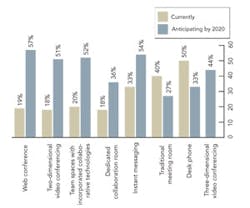The Collaborative Workplace of 2020
By 2020, collaborative workspaces will dominate over private offices, creating a gap between the level of teamwork that today’s workplace can support and the amount office workers will need by the end of the decade.
The study, led by Johnson Controls, shows that office workers anticipate spending more time working in team spaces that incorporate collaborative technologies. Interactive digital screens, touch surfaces, and global live video streaming will become the norm, according to over 1,700 respondents in seven countries.
The growing precedence of working in virtual teams is coupled with a decrease in the amount of time that employees need to spend at their desks, on the phone, or in fixed meeting rooms.
Companies should start to rethink how much dedicated office space they need, realizing that this shift in work habits can free up valuable real estate.
“We know that collaboration is a principal driver of creativity, innovation, and therefore business advantage,” says Dr. Marie Puybaraud, director of Global WorkPlace Solutions for Johnson Controls. “Failure to invest in collaborative technologies and updated workspaces will hamper productivity. This has an impact on people designing new workspaces or retrofitting existing ones today.”
The study suggests a one-size-fits-all workplace is less effective than one built for flexibility.
“This drive toward mass collaboration will change the way companies think about the real estate they occupy,” says Puybaraud. “A higher proportion of company floor-space will be designed specifically to support collaboration, which means understanding the interplay between people, the real estate portfolio, technologies, and working practices.”
To capitalize on this trend, consider hoteling desks, smaller offices, lounge furniture, and movable walls.
